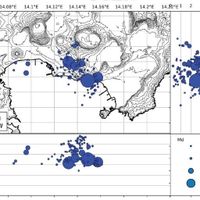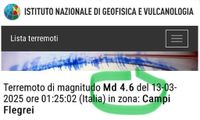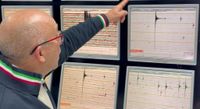The seismic activity in Naples and the Campi Flegrei area has surged into the limelight following the publication of the Weekly Bulletin on March 18, 2025, by the Osservatorio Vesuviano – INGV. This bulletin outlined significant earthquake activity occurring between March 10 and March 16, detailing how 138 preliminary earthquakes, each with a magnitude greater than or equal to 0.0, were located in the area. Throughout the week, residents faced heightened tension as the seismic unrest unfolded.
The earthquakes included two minor seismic swarms and a more significant swarm. The first minor swarm began at 02:57 CET on March 11, consisting of 33 earthquakes with a maximum magnitude of Md 3.0, located in the Solfatara-Pisciarelli area. This was followed closely by another minor swarm occurring from 06:25 on March 12 in the Agnano area, which included 7 earthquakes with a maximum magnitude of Md 1.7.
However, the most notable event of the week originated from a significant swarm starting at 01:25 UTC on March 13 in the Bagnoli area, registering 44 earthquakes with a maximum magnitude of Md 4.6 (±0.3). This event marked the strongest seismic occurrence in decades for the region, previously estimated at a magnitude of 4.4, demonstrating the volatile nature of the area's geological activity.
Mauro Di Vito, the director of the Osservatorio Vesuviano, explained the classification process for the earthquake reported at 1:25 a.m. on March 13. According to Di Vito, the identification process unfolds in three phases. Initially, there is immediate recognition of the earthquake, leading to a preliminary announcement within five minutes, especially for stronger earthquakes over 1.5 magnitude. This process then evolves to include more precise parameters concerning depth, location, and revised magnitudes within the following 30 minutes.
Di Vito highlighted that the detailed analysis conducted in subsequent days revealed that the event at 1:25 in the Bagnoli area was, in fact, comprised of two rapid-fire earthquakes that were almost indistinguishable from one another at many recording stations. He remarked, “Two earthquakes in quick succession whose duration magnitude equals 4.6 with an uncertainty of ±0.3 categorize this as the most energetic quake in the last forty years.”
This adjustment in classification has re-ignited fears among local residents, many of whom have been impacted by the recent seismicity characterizing their lives due to the ongoing bradisism in the area. The most current situation, according to the municipality of Naples, saw evacuations of 238 residents from 113 families, with 56 people temporarily housed in hotels, while others sought autonomous accommodation. At the Via Acate reception hub, 15 people were accommodated, and another 16 people found shelter at the Marechiaro 'San Francesco d'Assisi' facility.
The local government has kept a close eye on the situation, asserting that no grave structural damage was reported following the tremors. Schools and public facilities were reopened after thorough inspections, promoting an air of cautious optimism despite the ongoing challenges.
Despite the official stance, the rise of conspiracy theories has complicated the public narrative surrounding these seismic events. Some residents have voiced suspicions regarding the INGV's initial estimates, questioning if the organization deliberately downplays the magnitude of quakes to avoid public panic. This notion has fueled heated discussions across social media platforms, where misinformation can quickly spread.
Mauro Di Vito addressed these theories, maintaining that the reassessment of the magnitude was a necessary action founded on detailed scientific analysis. He emphasized, “The data already indicated that we were dealing with an earthquake featuring the highest parameters ever recorded.” He urged residents to remain calm, cooperate with authorities, and rely on credible information sources.
As March marches on, the stability of the ground in Campi Flegrei remains uncertain, with scientists observing a current uplift rate of 3 centimeters per month. As such, further seismic activity is likely, although predicting the timing and magnitude of future earthquakes remains challenging.
Di Vito also recounted an earlier quake on March 9, 2025, centered near Monterusciello, which marked a rare instance of seismic activity along the caldera's borders, underscoring the ongoing geological complexities that shape this part of Italy. He noted, “Events like this are infrequent, with another similar incident occurring near Quarto years ago. They stem from crustal deformation linked to ground uplift.”
For now, residents are left to navigate the uncertainty of their surroundings, weighing their innate fears against the reassurances from experts. With the Campi Flegrei region's rich geological history of seismicity, many are apprehensively anticipating the implications of a landscape that continuously shifts beneath their feet.






